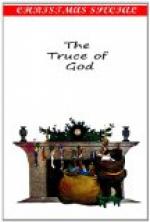One of the greatest evils of feudalism was that it fostered to excess the warlike spirit. Of its very nature, the system was a complex one. It gave rise to countless misunderstandings between the various grades of its involved hierarchy. The opportunities and plausible pretexts for misunderstandings, quarrels and war were many. A petty quarrel in Burgundy, in Champagne, in the Berry in France, involved not only the duke and count of these territories but almost every vassal or feudal lord in the province. The same might be said of the German nobles in Suabia, Thuringia and Franconia. Private wars were frequent, and though the barbarism of the past ages had almost completely disappeared under the teaching of the Gospel, these contests, as might be expected, were both sanguinary and wasteful.
The Church fought manfully against these private wars. It took every possible means to prevent them entirely. When in the nature of things, it found it impossible to do away with them altogether, it tried to mitigate their horrors, to limit their field of operation, to diminish their savagery. If the kingly authority was flouted, save perhaps when a sturdy ruler like William the Conqueror in England, or Hugh Capet in France, showed that there was a man at the helm, who meant to rule and was not afraid to quell rebellious earls and make them obey, there was one power these mail-clad warriors respected. They respected the Apostles Peter and Paul, they respected My Lord the Pope, and the Bishops of France and Normandy and England who shared in their authority. They flouted a king’s edict, but none but hardened criminals among them laughed at an episcopal or a Papal excommunication.
These rude men, and it places their rude age high in the scale of civilization, respected religion. They lowered the sword before the Cross. The Church had for the disobedient and the refractory one terrible weapon, which she was loath to use, but which she occasionally used with swift and tragic effect, the weapon of excommunication. Many a modern historian or philosopher has smiled good-naturedly and in mild contempt at this weapon used by the Church to frighten her children, much as children are frightened by flaunting some horrid tale of ogre or hobgoblin before them. Yet the student of history might profitably study the use which the Church has made of such an instrument, and find in it one of the most effective causes of social regeneration in the Middle Ages.
The Church, in order to fight the military and armed excesses of feudalism, employed many means. It is to her that we owe what is known as the “Truce of God,” or the enforced temporary suspension of hostilities usually, from the sunset of each Wednesday to Monday morning. Under pain of excommunication, during that interval, which at several times was further extended so as to comprise the seasons of Advent and Lent, and some of the major feasts, the sword might not be drawn in private quarrel. From a decree




